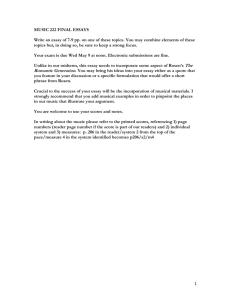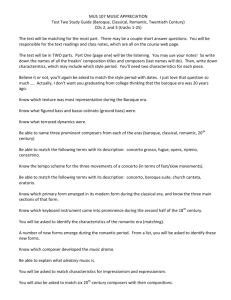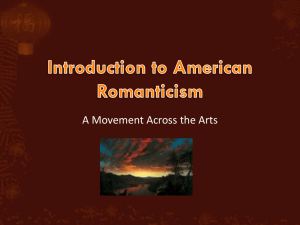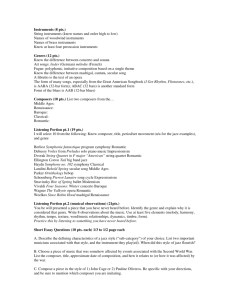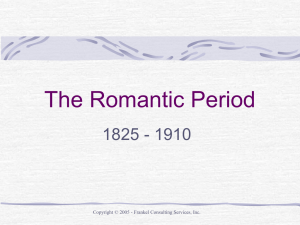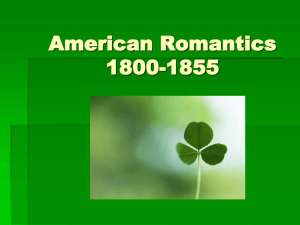The Romantic Period
advertisement
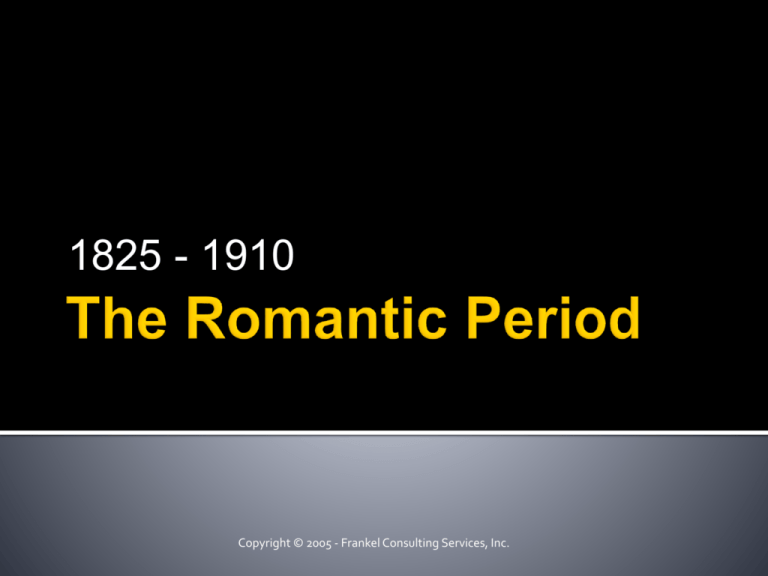
1825 - 1910 Copyright © 2005 - Frankel Consulting Services, Inc. The Romantic period began around 1825 and ended around 1910. Yes, there was some overlap between the classical period and romantic period. In fact, Beethoven bridged the two periods during his lifetime. 1825 - Erie Canal opens 1838 - Invention of photography 1846 - Neptune discovered 1861-1865 - American Civil War 1869 - Transcontinental Railroad completed 1872 - Brooklyn Bridge opens 1876 - Telephone invented 1886 - Statue of Liberty presented to New York 1893 - Henry Ford builds first car 1903 - Wright Brothers first airplane flight at Kitty Hawk, NC 1905 - E=mc2 - Einstein’s Theory of Relativity Charles Darwin Albert Einstein Abraham Lincoln Mark Twain Alexander Graham Bell Henry Ford Booker T. Washington Karl Marx Jack the Ripper Walt Whitman Ralph Waldo Emerson Edgar Allen Poe Emily Dickinson Van Gogh The Romantic movement in music coincides with a general Romantic movement in all arts. At this period, the arts of literature and painting began to influence music. In the Romantic era, music acquired poetic or philosophical meaning. Antiquity, folklore, history and exotic cultures were examined as possible sources of inspiration. Program music tells a story or describes something. Music is filled with passion and drama. Composers used music to overwhelm listeners with emotion, writing sad, sweeping pieces about love and heartbreak and magical fantasies about goblins, witches, and swans. The orchestra is arranged as we know it and was led by a conductor with a baton. The most popular instrument was the piano. Music is not as reliant on repetition as in Classical music The music often directly tells a story Exploration of tone colors Much larger orchestras. Popularity of chamber music Music is highly emotional Poetry and music are intimately fused Invention of the song cycle Invention of the symphonic poem Great works written for solo piano Composers stretched the listeners ear by creating a great deal of dissonance using chromatic notes, and extensions of the triad. Composers began to drift away from the strong sense of tonality heard in Classical music. Founding of conservatories Composers gradually left the patronage system and became free agents of their own works. This meant that the composer, their music and their livelihood depended on the public’s approval. For the first time, a composer’s work might not be publicly performed during his or her lifetime. Romantics saw themselves as outsiders, isolated from mainstream society, struggling to express their creative ideas. In general, composers held higher social status than in the Classical period. Rise of virtuosic performers the public was captured by virtuosity and showmanship Resulted from the orchestras growth in numbers and complexity Became necessary to have one person to lead and control the orchestra Melody Age of lyricism – unending melody Melodies appealed to the emotions Phrases tended to be longer and irregular in length Themes were more complex and utilized chromaticism Advent of theme transformation (Berlioz, Wagner) Rhythm Rhythmic effects were used for “color” – rubato Articulations in the instruments tended to be heavy and intense A new vocabulary of music terms arose that indicated how to achieve the composer’s desired sound – cantabile, dolce, allegro. These designations produced a more emotional sound and response. Texture Essentially homophonic Tended to be thick, heavy and lush Gradual Much wider range – extremes of dynamic variation Used extensively throughout the compositions This period saw a full exploration of the instrumental families. Instruments were used for both their individual and collective color potential. Instrumental timbre was used to convey mood and atmosphere. The orchestra became much larger – from 70 players to more than 100 (resulting in the necessity of a conductor). Instruments could play louder and carry farther. Instruments were capable of major changes in dynamics. String sections increased in size and were given more difficult accompaniment parts Development of new instruments Saxophone (invented by Adolf Sax.) piccolo, bass clarinet and English horn were added. Important improvements in wind instruments “Boehm system” of fingering for flutes and clarinets achieved better facility and intonation for the performer and greater musical range Addition of valves and improvement to valves on brass instruments allowed the playing of a full chromatic compass for the first time and to more easily play quick runs of notes Tubas and Trombones were added Expanded to include bass drum, snare drum, cymbals and other exotic percussion instruments (gong, castanets) Frederic Chopin Franz Liszt Johannes Brahms Modest Mussorgsky Felix Mendelssohn Peter Ilyich Tchaikovsky Richard Wagner Crucial figure in the transition from Classical to Romantic The Romantic period really began around 1815. Works from this period are characterized by their intellectual depth, their formal innovations, and their intense, highlypersonal expression. Web Web Web Web Web Web Web Russian composer Wrote 11 operas, 4 concertos, 6 symphonies, 3 ballets Most remembered for his ballets: Sleeping Beauty and Swan Lake Music is intense: Melancholy & emotional It has been speculated that he committed suicide Web Tuba Alto, Bass, Contrabass Clarinet Contrabassoon Euphonium Alto, Tenor, Baritone Saxophone Alto Flute Very popular during the Romantic era. Composers focused on melodies and themes. Huge interest in songs written as part of a cycle: a complete story told with related songs. 1. 2. 3. 4. 5. 6. 7. 8. 9. 10. Who bridged the Classical and Romantic time periods? What is program music? What was the most popular instrument? What does a conductor use to conduct the orchestra? What happened to the size of the orchestra during the romantic period? Name 3 instruments that were created? Name two pieces that Tchaikovsky was known for. Who invented the saxophone? True or False Music was more complex during the Romantic Period when compared to Classical Music. Use one word to describe music from the Romantic Period.

